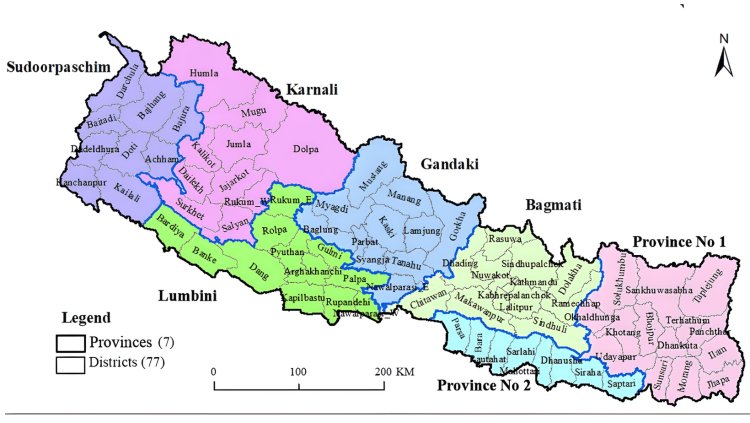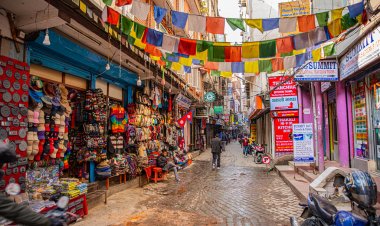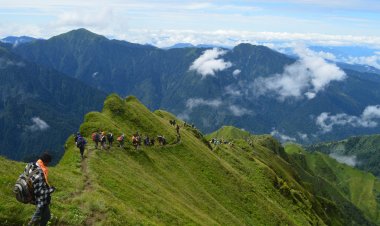Discover the Rich Diversity of Nepal's 77 Districts | Explore Nepal
Dive into Nepal's unique tapestry of culture, geography, and heritage across its 77 diverse districts. From the lush tea gardens of Ilam to the Himalayan wonders of Mustang and the spiritual essence of Lumbini, each district tells a story.

Introduction
Nepal's beauty lies not only in its towering peaks but also in the diversity of its districts. Journey through the country's 77 distinct regions, each with its own unique cultural tapestry and breathtaking landscapes. From the verdant tea gardens of Ilam in the east to the remote charm of Dolpa in the west, Nepal offers a captivating blend of traditions and terrains. Join us on an exploration of Nepal's cultural heritage, geographical wonders, and the stories that make each district a piece of Nepal's rich mosaic.
-
Ilam:
Ilam, located in Province 1, is known for its lush tea gardens. It's often referred to as the "Queen of Hills" due to its stunning natural beauty, including rolling hills covered in tea plantations. The district offers panoramic views of the Himalayas and is a popular destination for nature enthusiasts and trekkers. -
Jhapa:
Jhapa, in the southeastern Terai, is known for its fertile plains and agricultural activities. It's one of the most developed districts in the Terai region and shares a border with India. Jhapa is famous for producing crops like tea, rice, and cardamom, contributing significantly to Nepal's economy. -
Morang:
Morang, also in the Terai, is an economic hub of eastern Nepal. Its district headquarters, Biratnagar, is one of the largest cities in Nepal. Morang is known for its industries, trade, and agricultural productivity, making it a major contributor to the national economy. -
Sunsari:
Sunsari, adjacent to Morang, offers diverse landscapes, from the flat plains of the Terai to the lush hills in the north. It's agriculturally rich, with the Koshi Tappu Wildlife Reserve within its borders, providing a habitat for diverse flora and fauna. -
Dhankuta:
Dhankuta, a scenic hill district in the eastern region, boasts a rich cultural heritage and stunning natural beauty. The district is dotted with terraced fields, gushing rivers, and lush forests, making it a paradise for trekkers and nature lovers. -
Terhathum:
Terhathum is known for its serene landscapes and remote villages. It offers an authentic experience of traditional hill life in Nepal, with pristine forests and serene monasteries dotting the region. -
Sankhuwasabha:
Sankhuwasabha is famous for being the gateway to the Makalu Barun National Park, home to a variety of endangered species. The district is characterized by its rugged terrain, diverse ecosystems, and unique culture. -
Bhojpur:
Bhojpur, situated in the hilly region, is known for its natural beauty and rich cultural heritage. The district is home to diverse ethnic groups and offers trekking opportunities amidst breathtaking landscapes. -
Solukhumbu:
Solukhumbu, in northeastern Nepal, is world-renowned as the gateway to Mount Everest, the tallest peak on Earth. The district is a trekker's paradise, with stunning Himalayan vistas, Sherpa culture, and numerous monasteries. -
Okhaldhunga:
Okhaldhunga, the birthplace of Sir Edmund Hillary, is a hilly district known for its cultural significance and stunning natural beauty. It's a peaceful region with lush green hills and traditional villages. -
Khotang:
Khotang is a hilly district in the eastern region known for its terraced fields and a mix of ethnic communities. It offers a glimpse into the traditional lifestyle of the hills and is rich in cultural diversity. -
Udayapur:
Udayapur, situated in the eastern hills, is culturally diverse and blessed with a wealth of biodiversity. The district is known for its lush forests, rivers, and numerous festivals that celebrate its cultural heritage. -
Saptari:
Located in Province 2, Saptari is known for its fertile plains and agricultural activities, particularly rice cultivation. The district's vibrant culture is a blend of various ethnic groups, making it a diverse and lively region. -
Siraha:
Siraha, another district in the Terai, is celebrated for its religious and cultural significance. It's home to Janakpur, the birthplace of Goddess Sita, and hosts vibrant festivals and pilgrimages. -
Dhanusha:
Dhanusha is famous for being the birthplace of Lord Ram's consort, Goddess Sita. It's a hub of Hindu religious pilgrimage and boasts a rich cultural heritage, including intricate Maithili art and literature. -
Mahottari:
Mahottari, in the Terai, is known for its agricultural prowess and the cultivation of crops like rice, maize, and sugarcane. The district's culture is deeply rooted in traditional practices and festivals. -
Sarlahi:
Sarlahi, located in the Terai, is an agricultural district with fertile plains. It's known for its diverse ethnic communities and their unique traditions, making it a culturally rich region. -
Bara:
Bara is an industrial and commercial hub in the Terai, with cities like Kalaiya and Simara. The district's economy is driven by trade, manufacturing, and agriculture. -
Parsa:
Parsa is home to the bustling border town of Birgunj, a vital trade route between Nepal and India. The district is also known for the Parsa National Park, which houses a variety of wildlife. -
Rautahat:
Rautahat is culturally diverse and agriculturally rich. It's known for its traditional festivals and customs, which reflect the vibrant culture of the Terai. -
Sindhuli:
Sindhuli, in Bagmati Province, is known for its hilly terrain and agricultural activities. It's home to the historic Kamalamai Municipality and offers glimpses of rural Nepali life. -
Ramechhap:
Ramechhap is famous for its natural beauty, including hills, rivers, and lush forests. The district is also a gateway for trekking routes leading to popular destinations like Gaurishankar and Rolwaling. -
Dolakha:
Dolakha is known for its beautiful landscapes and cultural heritage. The district is home to the historical Dolakha Bhimsen Temple and is a center for traditional craftsmanship. -
Sindhupalchok:
Sindhupalchok, in Bagmati Province, boasts diverse geography, from the Terai in the south to the Himalayas in the north. It's known for its lush valleys, pristine rivers, and trekking trails. -
Kavrepalanchok:
Kavrepalanchok, in Bagmati Province, is celebrated for its cultural heritage and natural beauty. The district is home to the historic town of Panauti and is a popular destination for hiking and pilgrimages. -
Nuwakot:
Nuwakot is known for its historic Nuwakot Durbar, a fortress-like palace offering panoramic views of the Himalayas. The district's rugged terrain is dotted with traditional villages and forests. -
Rasuwa:
Rasuwa, in Bagmati Province, is a Himalayan district famous for its stunning scenery and trekking trails. The district also serves as the gateway to the Langtang National Park. -
Dhading:
Dhading, in Bagmati Province, is known for its scenic beauty, rivers, and hills. It's a district with a mix of ethnic communities and offers cultural diversity. -
Makwanpur:
Makwanpur, also in Bagmati Province, is characterized by a blend of hills and Terai. It's known for the picturesque Hetauda and the scenic Chitlang Valley. -
Chitwan:
Chitwan, located in Bagmati Province, is famous for the Chitwan National Park, a UNESCO World Heritage Site. The park is home to a variety of wildlife species, including rhinoceros and Bengal tigers, making Chitwan a popular destination for wildlife safaris and jungle adventures. -
Gorkha:
Gorkha, in Gandaki Province, holds immense historical significance as the birthplace of Prithvi Narayan Shah, the founder of the modern Nepali nation. The district offers picturesque landscapes, including hills, forests, and the Trishuli River, making it a hub for trekkers and history enthusiasts. -
Lamjung:
Lamjung, located in Gandaki Province, is celebrated for its natural beauty, including lush hills and rivers. The district is home to the historic Gorkha Durbar, which was the palace of the Shah dynasty rulers. -
Tanahun:
Tanahun, in Gandaki Province, is known for its rich cultural heritage and religious significance. The district is home to Bandipur, a picturesque hill station with well-preserved architecture and panoramic views of the Annapurna and Manaslu ranges. -
Syangja:
Syangja, also in Gandaki Province, offers diverse landscapes, including hills, rivers, and terraced fields. The district's cultural diversity is reflected in its festivals and traditional practices. -
Kaski:
Kaski, in Gandaki Province, is famous for the popular tourist destination, Pokhara. This city is renowned for its stunning lakes, caves, and its proximity to the Annapurna Mountain Range, making it a paradise for adventure seekers and nature lovers. -
Manang:
Manang, in Gandaki Province, is a high-altitude district known for its unique culture, landscapes, and role as a stopover for trekkers on the Annapurna Circuit. The district offers breathtaking views of the Himalayas and is a hub for Tibetan Buddhism. -
Mustang:
Mustang, often referred to as "Little Tibet", is located in Gandaki Province and is known for its rugged terrain, ancient monasteries, and preserved Tibetan culture. The district is a restricted area, making it a destination for those seeking an off-the-beaten-path adventure. -
Rupandehi:
Rupandehi, in Province 5, is renowned for Lumbini, the birthplace of Lord Buddha. This pilgrimage site attracts visitors from all over the world and is a UNESCO World Heritage Site. The district is also home to industrial and commercial centers. -
Nawalparasi:
Nawalparasi, situated in Province 5, is known for its diverse culture and geography. It serves as an important agricultural and trading hub, with bustling markets and a vibrant way of life. -
Kapilvastu:
Kapilvastu, in Province 5, is associated with the ancient kingdom of Shakya, where Siddhartha Gautama, who later became Buddha, was born. The district is dotted with historical and archaeological sites, including the ancient city of Tilaurakot. -
Arghakhanchi:
Arghakhanchi, in Province 5, is known for its agricultural productivity and serene landscapes. The district is characterized by terraced fields and traditional villages, offering a peaceful environment. -
Gulmi:
Gulmi, in Province 5, is a hilly district celebrated for its terraced fields, cultural diversity, and historic sites. It offers a mix of natural beauty and traditional living. -
Palpa:
Palpa, also in Province 5, is famous for the historic town of Tansen. This charming town boasts unique architecture and offers panoramic views of the Himalayas. The district is known for its traditional craftsmanship and festivals. -
Dang:
Dang, in Province 5, is known for its rich biodiversity, including the Dang Deukhuri Valley and the Dang Wildlife Reserve. The district's lush landscapes make it an attractive destination for nature enthusiasts. -
Pyuthan:
Pyuthan, in Province 5, is a hilly district characterized by its serene landscapes and traditional villages. The district offers a glimpse into rural Nepali life and customs. -
Rolpa:
Rolpa, in Province 5, is known for its cultural significance and historical role in the Maoist insurgency in Nepal. The district's rugged terrain and remote villages add to its unique charm. -
Rukum (Eastern and Western):
Rukum, divided into Eastern and Western regions, is known for its cultural diversity and scenic beauty. Both regions offer insights into the traditional lifestyle of the hills. -
Salyan:
Salyan, in Karnali Province, is a hilly district celebrated for its natural beauty, including hills, rivers, and forests. It's known for its unique culture and festivals. -
Surkhet:
Surkhet, the administrative hub of Karnali Province, is known for its cultural diversity and agricultural activities. The district's serene landscapes and traditional practices reflect the essence of rural Nepal. -
Dailekh:
Dailekh, in Karnali Province, is known for its rugged landscapes and cultural heritage. The district offers a glimpse into traditional Nepali life in the hills. -
Jajarkot:
Jajarkot, in Karnali Province, is a hilly district known for its remote villages and traditional lifestyle. The district's cultural richness is reflected in its festivals and customs. -
Dolpa:
Dolpa, located in Karnali Province, is a remote Himalayan district celebrated for its pristine landscapes and unique culture. It's home to the Shey Phoksundo National Park and offers trekking routes less traveled. -
Humla:
Humla, in Karnali Province, is known for its remote location, diverse cultures, and its role as a gateway to the Limi Valley and Mount Kailash in Tibet. The district's landscapes range from lush valleys to rugged mountains. -
Mugu:
Mugu, also in Karnali Province, is a remote district with stunning landscapes and cultural diversity. It's a trekking destination in the far-western region, offering a peaceful escape. -
Kalikot:
Kalikot, in Karnali Province, is known for its scenic beauty, traditional villages, and trekking opportunities. The district's terrain varies from hills to mountains, providing captivating views. -
Achham:
Located in the far-western region, Achham is known for its rugged terrain, traditional villages, and cultural diversity. The district's remote locations add to its unique charm. -
Bajhang:
Bajhang is a remote district in the far-western region, characterized by picturesque landscapes and a mix of ethnic communities. It offers an authentic experience of rural Nepal. -
Bajura:
Bajura is known for its stunning natural beauty, including hills, rivers, and forests. The district's traditional lifestyle and remote villages make it a destination for those seeking an off-the-beaten-path experience. -
Doti:
Doti is famous for its historical significance as the former capital of the Doti Kingdom. It offers beautiful landscapes and a cultural richness that reflects its ancient heritage. -
Kailali:
Kailali, in the far-western region, is known for its agricultural productivity and diverse cultures. The district's plains are ideal for rice and wheat cultivation. -
Kanchanpur:
Kanchanpur, situated in the southwestern Terai, is celebrated for its lush forests and the Shuklaphanta Wildlife Reserve. The district is a hotspot for biodiversity and conservation efforts. -
Darchula:
Darchula is a remote district in the far-western region, known for its challenging trekking routes and cultural diversity. It's a gateway to the Himalayas and offers breathtaking views. -
Baitadi:
Baitadi is known for its serene landscapes, traditional villages, and cultural heritage. The district is a peaceful retreat in the far west of Nepal. -
Dadeldhura:
Dadeldhura, a hilly district, offers beautiful scenery and a blend of cultural communities. The district's tranquil environment is ideal for nature enthusiasts. -
Dharchula:
Dharchula is known for its stunning Himalayan vistas and its location on the border with India. The district's remote villages provide insights into a traditional way of life. -
Baitadi:
Baitadi is known for its natural beauty, including hills, rivers, and forests. It's a district that appeals to those seeking a peaceful escape. -
Bheri (Jajarkot):
Bheri, formerly part of Jajarkot District, is known for its remote villages and hilly terrain. The district's landscapes vary from lush valleys to rugged mountains. -
Myagdi:
Myagdi is famous for its natural beauty and trekking destinations, including the Annapurna Circuit. The district's picturesque landscapes attract trekkers and adventure seekers. -
Parbat:
Parbat is a hilly district celebrated for its picturesque landscapes and cultural diversity. It offers a mix of natural beauty and traditional living. -
Baglung:
Baglung is known for its serene hill stations and the beautiful Dhorpatan Hunting Reserve. The district's landscapes range from hills to mountains. -
Achham:
Achham is famous for its rugged terrain, remote villages, and cultural diversity. It's renowned for its traditional villages that offer an authentic experience of rural Nepali life. The district is also known for its picturesque landscapes, including hills, rivers, and lush forests. -
Bajhang:
Bajhang is celebrated for its stunning natural beauty, characterized by hills, rivers, and forests. It's a remote district that provides an authentic experience of rural Nepal, with traditional villages and serene environments. -
Bajura:
Bajura is famous for its captivating natural beauty, including hills, rivers, and forests. The district's remote villages and traditional way of life make it an ideal destination for those seeking an off-the-beaten-path experience and a deeper connection with nature and culture. -
Doti:
Doti is renowned for its historical significance as the former capital of the Doti Kingdom. It offers beautiful landscapes and cultural richness that reflect its ancient heritage. The district's terrain, ranging from hills to mountains, provides opportunities for trekking and exploration. -
Kailali:
Kailali is known for its agricultural productivity and diverse cultures. The fertile plains of the district make it a vital contributor to Nepal's food production, particularly in crops like rice and wheat. The district's vibrant culture and traditional practices add to its appeal. -
Kanchanpur:
Kanchanpur is celebrated for its lush forests and the Shuklaphanta Wildlife Reserve. This district is famous for its biodiversity, housing a variety of flora and fauna, including Bengal tigers and Asian elephants. It's a significant area for wildlife conservation efforts in Nepal. -
Darchula:
Darchula is a remote district in the far-western region, known for its challenging trekking routes and cultural diversity. It serves as a gateway to the Himalayas, providing access to breathtaking views and remote villages. The district's rugged terrain and remote locations add to its unique charm, making it an attractive destination for trekkers and adventure seekers.
Conclusion
Nepal's districts, each a microcosm of the nation's diversity, offer a captivating experience. From the vibrant Terai plains to the tranquil hills and the towering Himalayas, Nepal's districts are a testament to its rich culture and natural beauty. Whether you seek adventure in the mountains or a deeper understanding of Nepali heritage, these 77 districts invite exploration. We hope this guide has inspired you to embark on a journey through Nepal's diverse tapestry, discovering the hidden gems and unique stories that await in every corner of this beautiful nation.
What's Your Reaction?




































































































